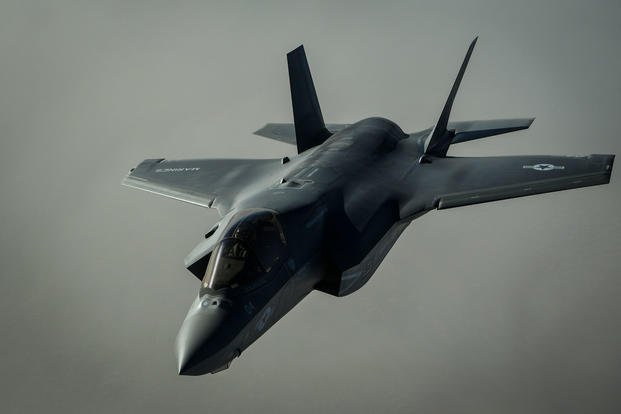The Pentagon has approved more than 80 percent of its operational F-35 Joint Strike Fighters to fly again after mandated inspections from the aircraft's Joint Program Office grounded the entire fleet last week.
The Air Force, Navy, Marine Corps and international partners "have resumed flying with their cleared aircraft," said JPO spokesman Joe DellaVedova.
Officials on Thursday temporarily suspended F-35 flight operations so that maintainers could conduct a fleet-wide inspection of a potentially faulty fuel tube inside the aircraft's engine.
The inspection followed an F-35B crash outside Marine Corps Air Station Beaufort on Sept. 28.
Related content:
- Pentagon Suspends All F-35 Operations After South Carolina Crash
- Watchdog Slams F-35 Program for Taking Shortcuts That Could Harm Troops
- Marine Corps F-35B Crashes in South Carolina, Pilot Ejected Safely
DellaVedova said Monday that if an engine had a "suspect fuel tube installed, the part would be removed and replaced."
"If the engine had a known good fuel tube installed, then the aircraft could return to flight status," he added.
It was not immediately clear how many of the Lockheed Martin Corp.-made F-35s were found with the flawed fuel tube, or which variants were affected.
Some F-35 units within the Navy and Air Force resumed operations less than 24 hours after the grounding was announced. International partners such as Italy, the United Kingdom and Israel also returned to normal flight operations within about 48 hours.
DellaVedova did not specify which aircraft still weren't cleared to fly, but said the JPO is working closely with the military services "to prioritize fuel tube replacements using the current spares inventory."
"Pratt & Whitney is rapidly procuring more parts to minimize the overall repair timeline for the remaining jets," he said, referencing the jet's engine maker. "Current inventory will restore about half of the impacted jets to flight operations, and the remaining aircraft are expected to be cleared for flight over the coming weeks."
The setback, he said, is not expected to impact F-35 deliveries. The program timeline remains on track to meet the target of 91 aircraft for the year, DellaVedova said.
"More than 1,500 suppliers are on the F-35 program, and this is an isolated incident, which is quickly being addressed and fixed," he said in the statement. "Safety is our primary goal, and we will continue to take every measure to ensure safe operations while we execute our mission."
Maintainers were inspecting the fuel tube for quality assurance, an official close to the F-35 program told Military.com last week.
"This is engine-by-engine, aircraft-by-aircraft. [It is] not a grounding where all aircraft need to sit out to for a select period of time," said the source, who declined to be publicly identified.
The official said aircraft across all services could be back in the air very shortly upon inspection.
Following the crash, the grounding is the latest in a series of incidents for the program.
Last month, a Navy F-35C assigned to the California-based Strike Fighter Squadron 125 made an unexpected landing at Fresno Yosemite International Airport after an indicator light lit up. No injuries were reported.
In August, an F-35 with that same squadron was damaged during an aerial refueling exercise along with an F/A-18F Super Hornet.
That same day, two Air Force F-35As experienced mishaps in Florida. One stealth fighter suffered a nose-gear malfunction and another struck a bird.
Earlier this year, the Pentagon temporarily suspended acceptance of new Joint Strike Fighters over corrosion issues. Corrosion occurred in fastener "holes that were drilled and not corrected or properly treated found during an inspection at Hill Air Force Base, [Utah]," Lt. Gen. Arnold Bunch, the Air Force's military deputy for the Office of the Assistant Secretary for Acquisition at the Pentagon, said in March.
Officials roughly two months later said the JPO had again begun accepting the stealth aircraft after suspending deliveries from Lockheed Martin over a disagreement over who would pay to correct corrosion issues due to the production error.
In September 2016, the Air Force ordered a temporary stand-down of 13 out of 104 F-35s in the fleet, "due to the discovery of peeling and crumbling insulation in avionics cooling lines inside the fuel tanks," Air Force spokeswoman Ann Stefanek said at the time.
That same month, pooled fuel in the tailpipe of an F-35 resulted in a fire at Mountain Home Air Force Base, Idaho.
-- Oriana Pawlyk can be reached at oriana.pawlyk@military.com. Follow her on Twitter at @Oriana0214.










